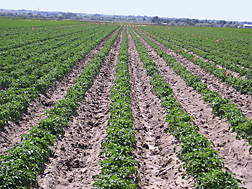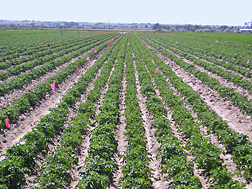A New Arrangement for Potato Production
|
|
When Idaho farmers started making the state famous for its potatoes, they seeded their crops in ridged rows and watered the plants by channeling surface irrigation to flow through the furrows between the rows. But even though most commercial potato producers in the Pacific Northwest now irrigate their crops with sprinklers, they still typically use ridged-row planting systems.
“The problem is that sprinkler irrigation can actually work against efficient water management because runoff from the sides of a ridged potato row allows water to pond in the furrow,” says agricultural engineer Bradley King, who works at the ARS Northwest Irrigation and Soils Research Laboratory (NWISRL) in Kimberly, Idaho. “So some of the irrigation water is wasted because the excess water in the furrows percolates below the crop root zone and becomes unavailable to the plants. Under these conditions, nitrate leaching from the soil can increase.”
King worked with NWISRL research leader Dave Bjorneberg and soil scientist David Tarkalson on a series of studies to see whether planting potatoes in flat beds instead of ridged rows could increase irrigation water-use efficiency and the overall efficiency of potato production. For a 2-year study, they set up experimental fields near their laboratory in Kimberly and compared three planting systems: conventional ridge-row systems, a five-row planting configuration on a raised bed where the plant rows were 26 inches apart, and a seven-row planting configuration on a raised bed where the plant rows were 18 inches apart. They also varied nitrogen application and irrigation rates for the experimental beds.
|
|
With the help of a grant from the U.S. Department of Agriculture’s Natural Resources Conservation Service (NRCS) and assistance of industry partner Western Ag Research LLC, the team also set up a 5-year study with commercial producers in eastern Idaho on 62 fields, a study area that totaled around 6,900 acres. They looked at how irrigation rates and variety selection affected yields for each producer, but in this study, they only compared ridged-row systems and five-row raised-bed systems.
Results? The researchers found that using the flat-bed system increased yields by an average of 6 percent, even though 5 percent less water was used for irrigation—which meant that using flat beds instead of ridged rows for potato production led to a 12 percent increase in irrigation water use efficiency. They attribute these gains to several factors, especially the probability that planting potatoes in flat beds improves water- and nitrogen-use efficiency because more water reaches the potato roots.
These findings, which were published in 2011 in the American Journal of Potato Research, could help commercial farmers in Idaho and other states increase yields and profits, save valuable water resources, and reduce nitrate leaching. Idaho farmers who use a high level of irrigation water management—methods identified by NRCS that help producers monitor soil moisture needs, such as electronic moisture sensors and data loggers—in combination with the potato bed planter are now eligible for state funding.
The work could also create new opportunities for farmers who are looking for ways to increase production efficiencies in the cultivation of specialty potatoes for niche markets.
King concludes, “What’s great about the results is that this is another example of where a conservation measure can also result in increased income.”—By Ann Perry, Agricultural Research Service Information Staff.
This research is part of Climate Change, Soils, and Emissions (#212) and Water Availability and Watershed Management (#211), two ARS national programs described at www.nps.ars.usda.gov.
To reach scientists mentioned in this story, contact Ann Perry, USDA-ARS Information Staff, 5601 Sunnyside Ave., Beltsville, MD 20705-5129; (301) 504-1628.
"A New Arrangement for Potato Production" was published in the September 2011 issue of Agricultural Research magazine.








